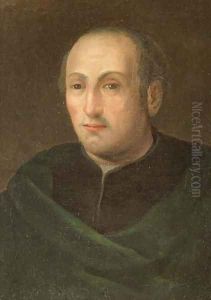Giuseppe Calendi Paintings
Giuseppe Calendi was an Italian painter and engraver, born in 1749 in Livorno, Italy, and passed away in 1833. Although not as widely recognized as some of his contemporaries, Calendi made significant contributions to the Italian art scene of the late 18th and early 19th centuries. His work primarily falls within the Neoclassical movement, which sought to revive the styles and themes of classical antiquity. This period in art history was marked by a fascination with the ancient worlds of Greece and Rome, emphasizing harmony, clarity, and strong linear forms.
Calendi's artistic journey began with his education at the Academy of Fine Arts in Florence, where he was a pupil of the renowned painter and engraver, Violante Beatrice Siries. Under Siries’ tutelage, Calendi honed his skills in both painting and engraving, with a particular focus on historical and mythological subjects that were popular among Neoclassical artists. His works are characterized by their meticulous attention to detail, balanced compositions, and the use of light and shadow to achieve depth and realism.
Throughout his career, Calendi received commissions from various Italian nobility and institutions, which helped to establish his reputation as a skilled painter and engraver. Some of his notable works include frescoes for the Palazzo Pitti in Florence, as well as several altarpieces for churches in his native Livorno and the surrounding region. Despite the prestige these commissions afforded him, Calendi's work remained relatively localized to Tuscany, and as a result, his fame did not spread as widely as some of his peers.
After his death in 1833, Giuseppe Calendi's contributions to the Neoclassical movement began to be overshadowed by the rise of Romanticism and later artistic movements. However, in recent years, there has been a renewed interest in his work among art historians and collectors, recognizing him as an important figure in the transition between the Baroque and Neoclassical periods. Today, Calendi's surviving works offer valuable insights into the artistic trends and cultural attitudes of late 18th and early 19th century Italy, embodying the elegance and precision that define Neoclassical art.
